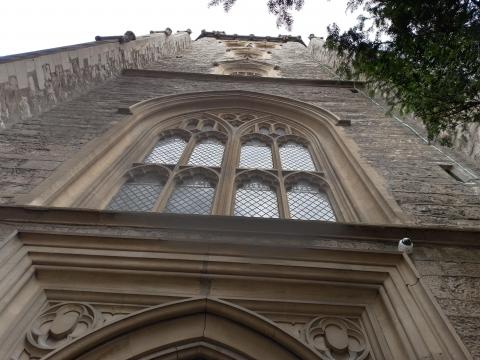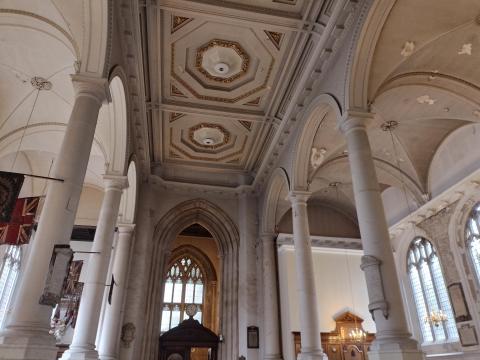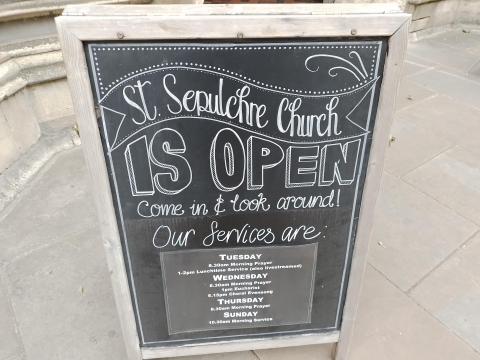Church of St Sepulchre

St Sepulchre is a strange name for a London church, for no individual called 'Sepulchre' was ever canonised. The word means tomb or grave, which makes it all the more bizarre. An explanation is offered on a blue sign by its main entrance. It was once known as St Edmund’s Church, but the Augustinian Canons cared for it in the twelfth century who were also connected to the Holy Sepulchre church in Jerusalem, built on the likely site of Christ’s crucifixion, tomb or both. With time’s passage, the name was abbreviated to what we have today: the Church of St Sepulchre.

Another notable association is that of John Rogers, England’s first Protestant martyr from the reign of Bloody Mary. He once assisted William Tyndale with his translation of the scriptures into English. In 1550, Roger became minister at St Seps. As well as courageously criticising the Protestant government for its squandering of monastic wealth, he never shirked from preaching pure Protestant doctrine even when little King Edward died and his dreadful sister Mary acceded to the throne. He was duly arrested and in January 1555, was condemned to die as heretic. John Foxe records:
After Mr. Rogers had been long and straitly imprisoned, and lodged in Newgate among thieves, often examined, and very uncharitably entreated, and at length unjustly and most cruelly condemned by Stephen Gardiner, bishop of Winchester, the fourth day of February, in the year of our Lord 1555, being Monday in the morning, he was suddenly warned by the keeper of Newgate's wife, to prepare himself for the fire; who, being then sound asleep, could scarce be awaked. At length being raised and awaked, and bid to make haste, then said he, "If it be so, I need not tie my points." And so was had down, first to bishop Bonner to be degraded: which being done, he craved of Bonner but one petition; and Bonner asked what that should be. Mr. Rogers replied that he might speak a few words with his wife before his burning, but that could not be obtained of him.
When the time came that he should be brought out of Newgate to Smithfield, the place of his execution, Mr. Woodroofe, one of the sheriffs, first came to Mr. Rogers, and asked him if he would revoke his abominable doctrine, and the evil opinion of the Sacrament of the altar. Mr. Rogers answered, "That which I have preached I will seal with my blood." Then Mr. Woodroofe said, "Thou art an heretic." "That shall be known," quoth Mr. Rogers, "at the Day of Judgment." "Well," said Mr. Woodroofe, "I will never pray for thee." "But I will pray for you," said Mr. Rogers; and so was brought the same day, the fourth of February, by the sheriffs, towards Smithfield, saying the Psalm Miserere by the way, all the people wonderfully rejoicing at his constancy; with great praises and thanks to God for the same. And there in the presence of Mr. Rochester, comptroller of the queen's household, Sir Richard Southwell, both the sheriffs, and a great number of people, he was burnt to ashes, washing his hands in the flame as he was burning. A little before his burning, his pardon was brought, if he would have recanted; but he utterly refused it. He was the first martyr of all the blessed company that suffered in Queen Mary's time that gave the first adventure upon the fire. His wife and children, being eleven in number, ten able to go, and one sucking at her breast, met him by the way, as he went towards Smithfield. This sorrowful sight of his own flesh and blood could nothing move him, but that he constantly and cheerfully took his death with wonderful patience, in the defence and quarrel of the Gospel of Christ."
Well might his living be called St Sepulchre’s, for he was sent to a painful, early grave for Christ’s great truth. And like the tomb of Christ Himself, the door of which was broken by resurrection power, so too Master Rogers broke free of the sepulchre and all its popish darkness.

- Log in to post comments


 Sunday Worship 10.45am & 6.00pm
Sunday Worship 10.45am & 6.00pm